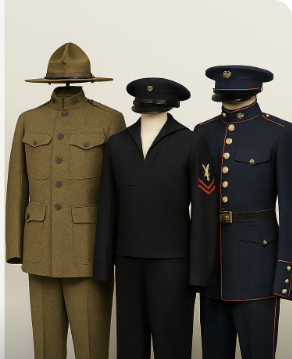
The Fascinating World of WWI Uniform Collecting: A Guide to American Army Uniform History & Beyond
Published on Oct 01, 2025
Introduction:
Are You Wearing History?
Did you know a pristine WWI American Doughboy uniform can fetch over $1,000 at auction today? For history buffs and collectors alike, WWI uniform collecting isn’t just a hobby—it’s a way to preserve and relive the past.
Suppose you're fascinated by the American army uniform history, WWI and WWII military gear, or the evolution of Marine Corps colours and the blue Marine uniform. In that case, you're in the right place. This guide explores how to start collecting, where to find authentic pieces, mistakes to avoid, and what today’s collectors are seeking—from CPO uniforms to US Army current camo patterns.
Let’s dive into a rewarding journey through the fabric of history.
Why Collecting WWI Uniforms is More Than Just a Hobby
WWI marked a dramatic shift in how nations outfitted their soldiers. From wool tunics to early camouflage, the uniforms of this era tell deep, personal stories of war and survival.
Benefits of uniform collecting:
- Connect with personal and national history
- Build valuable collections over time
- Learn craftsmanship and materials of different eras
- Engage with a passionate collector community
Whether you're drawn to the rugged look of trench coats or the iconic blue marine uniform, this hobby is a way to own a piece of world history.
Getting Started: Understanding American Army Uniform History
Why American Army Uniform History Matters
Collecting without context is like reading without comprehension. Knowing the American army uniform history helps identify authentic pieces and adds value to your collection.
Quick timeline snapshot:
- 1902: Olive drab replaces blue in field use
- 1917-1918: WWI uniforms standardized—breeches, tunics, hobnail boots
- 1941-45: WWII sees greater use of khaki and functional design
- Today: The US Army's current camo is known as OCP (Operational Camouflage Pattern)
When evaluating uniforms, note key identifiers:
- Insignia placement
- Labeling/stamping
- Stitching and wear
- Manufacturer tags
Understanding these details will help distinguish between a 1918 Army tunic and a later reproduction.
Where to Find Authentic WWI Uniforms
Online Marketplaces
- eBay: Large selection, but be wary of fakes
- Militaria Forums: Collectors often sell or trade
- Specialist Auction Houses: Higher prices, but better authenticity
- Facebook Collector Groups: Great for networking and deals
In-Person Sources
- Military surplus stores (some carry vintage)
- Estate sales
- Antique stores
- Military museums (some have sales or fundraisers)
Pro Tip:
Start small. Buy a WWI helmet or cap before committing to full tunics or complete sets.
Actionable Tips for First-Time Collectors
1. Learn the Lingo
Know terms like:
- CPO Uniform: Chief Petty Officer Navy uniform, not to be confused with Army gear
- Patches and Unit Badges: Key to identifying regiments
- Service Stripes and Campaign Ribbons: Reveal service history
2. Set a Budget
- Start with a monthly cap
- Save for rare items
- Expect to pay:
- $100–300 for a WWI tunic
- $50–100 for authentic field gear
- $20–75 for caps or belts
3. Keep It Documented
- Photograph each piece
- Note where and when it was bought
- Research and store documentation for the item
4. Join a Community
Sites like USMF (US Militaria Forum) are goldmines for tips, appraisals, and camaraderie.
Avoiding Common Pitfalls in WWI Uniform Collecting
- Buying Reproductions as Originals
- Repros often use incorrect fabric or stitching
- Always request detailed photos or certification
- Neglecting Preservation
- Store in a climate-controlled space
- Avoid direct sunlight and humidity
- Use acid-free tissue and cotton gloves
- Overpaying Early On
- Use price guides
- Ask in forums before buying
- Don’t impulse bid in auctions
- Mixing Eras by Mistake
- Uniform styles vary even within WWI (1917 vs. 1918 cuts)
- Marine vs. Army vs. Navy uniforms have clear differences
Spotlight: Marine Corps Colors & Blue Marine Uniforms
While the focus is often on Army gear, collectors shouldn’t ignore Marine Corps colours and the iconic blue Marine uniform.
Marine Uniform Collecting Tips:
- Look for “EGA” (Eagle, Globe, and Anchor) insignia
- Pay attention to the red piping on the dress blues
- Know that Marine gear differs significantly in cut and decor from Army uniforms
A full blue marine uniform with accessories like gloves, cover, and belt can be highly collectible and visually stunning.
Current Trends in Military Uniform Collecting
The world of uniform collecting is evolving. Here's what's hot in 2025:
1. US Army Current Camo Patterns
Modern camouflage like OCP is gaining traction among younger collectors. It's affordable and accessible and connects to recent military history.
2. WWII-to-Modern Cross-Era Collections
Collectors are now blending WWI, WWII, and Gulf War-era pieces to show evolution over time.
3. Digitally Verified Uniforms
NFT-style certificates of authenticity are emerging, especially for high-value items.
4. Social Media Showcases
Instagram and YouTube channels dedicated to uniform restoration and history are booming. Share your finds!
Preserving and Displaying Your Collection
Your collection deserves to be seen—and protected.
Preservation Tips:
- Use mannequins or padded hangers for tunics
- Display in UV-protected cases
- Avoid plastic storage bins (can trap moisture)
Great Display Ideas:
- Shadow boxes for insignia
- Themed shelves (e.g., WWI trench gear, Navy dress sets)
- QR codes linking to the uniform’s history or origin story
Conclusion: Start Your Journey with American Army Uniform History
Whether you're after a pristine WWI tunic, a weathered CPO uniform, or an eye-catching blue marine uniform, uniform collecting opens doors to historical discovery. Knowing your American army uniform history isn’t just trivia—it’s a toolkit that helps you make informed decisions, avoid scams, and appreciate the deep stories behind each piece.
